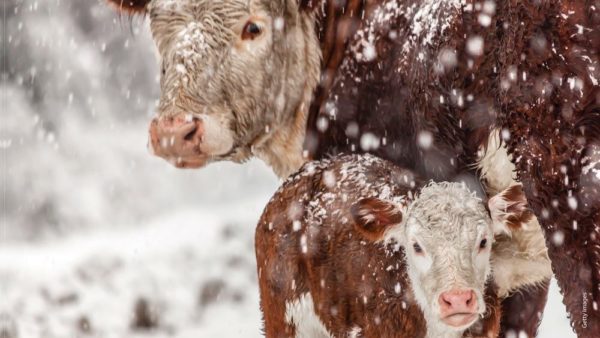Peace of Mind on the Ranch: Livestock Insurance Helps Protect Against Weather and Market Risks
Raising livestock can be a rewarding but sometimes risky business. Fortunately, you can take steps to control the risks involved. One risk management tool available to producers is livestock insurance. It can pay off both financially and in peace of mind.
“The insurance helps me sleep better at night. It’s another management tool in the arsenal to prevent dramatic loss. It’s good for Farm Credit and other bankers, too—it helps assure that you can repay your loans.” – Joe David Yates, Texas rancher
Mortality insurance pays after blizzard
Gregg Sides has seen plenty of cattle-killing weather in the Texas Panhandle, where he raises calves on grass and winter wheat near Dimmitt.
Recognizing that weather is one risk he can’t control, Sides decided five years ago to insure against catastrophes by purchasing livestock mortality insurance. This type of coverage insures the herd in the event of death from natural causes such as a blizzard, tornado, lightning, fire or accident.
“If a tornado hit, I could be back to square one,” Sides says. “I’m glad I have this insurance.”
To date, he has filed one claim—after the “Goliath blizzard” that hit the southern Plains in December 2015—and was reimbursed for the loss of a number of cattle after meeting his policy deductible of $10,000.
“Natural disasters of recent years—the drought of 2011, the Goliath blizzard of 2015, the Panhandle fires and Hurricane Harvey of 2017—are fresh reminders of the benefits of purchasing livestock mortality insurance,” says Sides’ agent, Janell Turner, insurance specialist at AgTexas Farm Credit Services in Amarillo. “Claims spiked after Goliath, and sales continue to climb.”

Sleep better with market list coverage
Meanwhile, in the Texas Hill Country, cow-calf producer Joe David Yates of Llano advocates for insurance that protects livestock growers in the marketplace.
Yates learned about livestock risk protection (LRP) when his lender, Capital Farm Credit, started offering crop and livestock insurance a few years ago. With LRP, he sets a floor price for a specific number of head for a specific time period.
He has collected insurance payments once—when the market price dropped below his floor price—and he plans to continue the coverage.
“The insurance helps me sleep better at night,” Yates says. “It’s another management tool in the arsenal to prevent dramatic loss. It’s good for Farm Credit and other bankers, too—it helps assure that you can repay your loans.”
Before Yates learned about LRP insurance, he purchased futures hedging products from commodities brokers, but grew tired of paying margin calls when the equity in his account fell below his maintenance margin.
“When you purchase livestock insurance, that’s your last expense,” he says. “You can plan your fixed costs.”
According to Charlie Johnson, an insurance representative with Texas Farm Credit Services, volatility in the cattle market over the past three years has been driving the growth of market-based livestock insurance. Johnson, who has a commodities brokerage license, reports that his customers find livestock risk protection insurance simpler than brokerage products.
“You don’t have to go through a broker, there’s no brokerage fee, and there are no margin calls,” he says.
Interest in livestock insurance builds
First piloted by the USDA in 2007, livestock insurance is generally not as well-known as crop insurance. But that’s changing, as producers learn about the benefits.
“We expect interest in livestock insurance to build,” Turner says. “The cost of land and feed continues to squeeze margin potential. With increased costs, coupled with a volatile market, capital requirements for a livestock producer are much greater than they used to be. Livestock insurance is a great way to protect your investment.”
Congress will soon debate the next farm bill, which will determine the future of livestock insurance. But as Turner says, “Congress is aware that this is the most important safety net for America’s farmers and ranchers.”
Arthur “Tootie” Ilse, who heads of Capital Farm Credit insurance operations, echos her comments.
“We sell insurance, but what we’re really doing is protecting the family farm from financial disruption—and that’s more important than anything. This type of coverage could keep a producer in business fo another year,” Ilse says. “I’ve had a few customers tell me that if it hadn’t been for our insurance, they would have to do something else.”
Key benefits of livestock insurance
- It reduces your risk; you’ll be reimbursed for your losses.
- You can plan your budget more accurately.
- Lenders may be more willing to provide loans, knowing you are protected from losses.
Choose from five livestock insurance options
Prices and policies may differ for these products, which are offered by private insurers:
- Feedlot, dairy and pasture insurance covers perils including fire and tornados.
- Full mortality insurance protects against death of livestock from natural causes including drowning, sickness, disease, accident, fire and lightning. It’s available for cattle and horses, and for show, breeding and exotic animals.
Administered by USDA’s Risk Management Agency (RMA), which sets national rules and prices, these types of insurance are offered by private insurers and some Farm Credit cooperatives:
- Livestock risk protection (LRP) covers a drop in the market price on feeder cattle, fed cattle, swine and lambs. You secure a floor market price for a certain number of head and for a specified period. If, at the end of the period, the national cash index is below your policy’s floor price, you’re reimbursed for the difference.
- Livestock gross margin (LGM) insurance covers losses by insuring expected gross margin versus actual gross margin in yearling, calf-finishing, dairy and swine operations. For dairy producers, for example, it provides protection if feed costs rise or milk prices drop.
- Pasture, rangeland and forage insurance (PRF) covers loss of pasture and forage due to lack of rainfall and declining vegetation.
To learn more about RMA-administered insurance products, visit www.rma.usda.gov, and click on livestock policies, or search for “pasture, rangeland and forage pilot program.”
Article Courtesy of Land.com written by FARM CREDIT BANK OF TEXAS MARCH 14, 2018
Peace of Mind on the Ranch: Livestock Insurance Helps Protect Against Weather and Market Risks

The Boehm Team | (830) 428-8106 | info@MyBoehmTeam.com
Texas Ranches for Sale
Featured Properties
